- Home
- About
- Map
- Trips
- Bringing Boat West
- Migration West
- Solo Motorcycle Ride
- Final Family XC Trip
- Colorado Rockies
- Graduates' XC Trip
- Yosemite & Nevada
- Colorado & Utah
- Best of Utah
- Southern Loop
- Pacific Northwest
- Northern Loop
- Los Angeles to NYC
- East Coast Trips
- Martha's Vineyard
- 1 Week in Quebec
- Southeast Coast
- NH Backpacking
- Martha's Vineyard
- Canadian Maritimes
- Ocracoke Island
- Edisto Island
- First Landing '02
- Hunting Island '02
- Stowe in Winter
- Hunting Island '01
- Lake Placid
- Chesapeake
- Provincetown
- Hunting Island '00
- Acadia in Winter
- Boston Suburbs
- Niagara Falls
- First Landing '99
- Cape Hatteras
- West Coast Trips
- Burning Man
- Utah Off-Roading
- Maui
- Mojave 4WD Course
- Colorado River Rafting
- Bishop & Death Valley
- Kauai
- Yosemite Fall
- Utah Off-Road
- Lost Coast
- Yosemite Valley
- Arizona and New Mexico
- Pescadero & Capitola
- Bishop & Death Valley
- San Diego, Anza Borrego, Joshua Tree
- Carmel
- Death Valley in Fall
- Yosemite in the Fall
- Pacific Northwest
- Utah Off-Roading
- Southern CA Deserts
- Yosemite & Covid
- Lake Powell Covid
- Eastern Sierra & Covid
- Bishop & Death Valley
- Central & SE Oregon
- Mojave Road
- Eastern Sierra
- Trinity Alps
- Tuolumne Meadows
- Lake Powell Boating
- Eastern Sierra
- Yosemite Winter
- Hawaii
- 4WD Eastern Sierra
- 4WD Death Valley +
- Southern CA Deserts
- Christmas in Tahoe
- Yosemite & Pinnacles
- Totality
- Yosemite & Sierra
- Yosemite Christmas
- Yosemite, San Diego
- Yosemite & North CA
- Seattle to Sierra
- Southwest Deserts
- Yosemite & Sierra
- Pacific Northwest
- Yosemite & South CA
- Pacific Northwest
- Northern California
- Southern Alaska
- Vancouver Island
- International Trips
- Index
- Tips
- Books
- Photos/Videos
- Search
- Contact
Lava Beds National Monument, CA
Friday, September 27, 2013 - 3:45pm by Lolo
84 miles and 2.5 hours from our last stop - 1 night stay
Travelogue
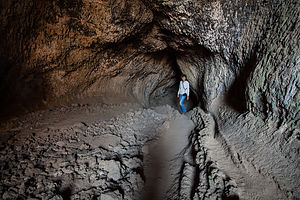 Lolo at Entrance of CaveAs much as I hate to, I am going to have to give Herb total credit for this stop. Although I do most of the research and trip planning, every once in a while Herb comes up with a destination that I never even thought of. What I hate to say even more is that usually he picks a winner. Lava Beds had not even been on my radar. In fact, to be honest, I’m not sure if I had even heard of it before he started bringing it up.
Lolo at Entrance of CaveAs much as I hate to, I am going to have to give Herb total credit for this stop. Although I do most of the research and trip planning, every once in a while Herb comes up with a destination that I never even thought of. What I hate to say even more is that usually he picks a winner. Lava Beds had not even been on my radar. In fact, to be honest, I’m not sure if I had even heard of it before he started bringing it up.
Perhaps, it was our new found interest in geology. After years of visiting the national parks and understanding very little regarding their geological formation, Herb and I discovered TTC (The Teaching Company) videos of various college courses. Every morning after breakfast, we dutifully sit down with a cup of coffee and watch a ½ hour lecture on a particular subject. We had just completed two entire courses on geology (18 hours each), and were anxious to go out and apply our new found knowledge. I really wish we had watched these years ago, because it is so much more interesting to visit a place when you understand how it came to be.
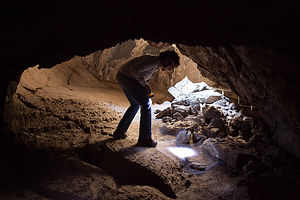 Lolo in Sunshine CaveLava Beds National Monument is pretty small, so it can be covered pretty easily in a day. The park road is only about 15 miles long and most of the interesting sights are conveniently located along the way.
Lolo in Sunshine CaveLava Beds National Monument is pretty small, so it can be covered pretty easily in a day. The park road is only about 15 miles long and most of the interesting sights are conveniently located along the way.
Although we entered the park from the north, we drove directly through it to the southern end, where the Visitor Center and campground were, avoiding the temptation of stopping along the way. We would come back once we had dropped the motorhome off at the campground. Plus, it’s always more useful to go to the Visitor Center first, so you know what the park has to offer.
The remoteness of this park makes is a little visited one, so we had no trouble getting a campsite in Indian Wells, the only campground in the park. After decoupling the Subaru, we set out for a full day of exploration.
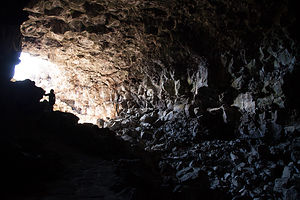 Lolo Leaving Skull CaveOur first stop was the Visitor Center, where we unexpectedly got cleared for White-Nose Bat Disease -- not unexpected that we didn't have it, but rather that such a disease even existed. This disease, named for the distinctive white fungal growth around infected bats’ noses, has been responsible for the death of millions of North American bats. To prevent the spread of this devastating disease, park rangers want to make sure that visitors are not wearing shoes or hiking boots that have been in other caves with bats, especially in the Northeast where the disease originated. Although we had been in many bat caves in recent years, we were sporting brand new hiking boots, so we were good to go.
Lolo Leaving Skull CaveOur first stop was the Visitor Center, where we unexpectedly got cleared for White-Nose Bat Disease -- not unexpected that we didn't have it, but rather that such a disease even existed. This disease, named for the distinctive white fungal growth around infected bats’ noses, has been responsible for the death of millions of North American bats. To prevent the spread of this devastating disease, park rangers want to make sure that visitors are not wearing shoes or hiking boots that have been in other caves with bats, especially in the Northeast where the disease originated. Although we had been in many bat caves in recent years, we were sporting brand new hiking boots, so we were good to go.
I can understand why the park is so concerned about protecting their caves. These are their treasures. It is these lava tube caves that make the park unique among its volcanic peers, of which there are many along the Pacific Ring of Fire. They were formed thousands of years ago when the Medicine Lake shield volcano erupted, spewing hot molten lava. The outer edges of the lava cooled and hardened first, while the warmer inner core of lava continued to flow within, forming a giant underground tunnel system of tubes and caves.
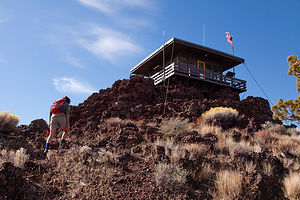 Hiking to Schonchin Butte LookoutWithin the park there are over 330 of these lava caves. About 15 of them have developed entrances and trails for visitors to explore. Some of them are easy with relatively high ceilings and smooth floors, others require you to stoop and have rougher floors, and the most challenging have portions where you have to crawl on your hands and knees through narrow openings. All you need are sturdy shoes, a good flashlight, and a helmet and kneepads (for the more challenging caves).
Hiking to Schonchin Butte LookoutWithin the park there are over 330 of these lava caves. About 15 of them have developed entrances and trails for visitors to explore. Some of them are easy with relatively high ceilings and smooth floors, others require you to stoop and have rougher floors, and the most challenging have portions where you have to crawl on your hands and knees through narrow openings. All you need are sturdy shoes, a good flashlight, and a helmet and kneepads (for the more challenging caves).
While Herb and I usually like to think we can handle a challenge, neither one of us had any desire to crawl along a damp, rough floor in the dark on our hands and knees. The Easy and Moderate caves hikes sounded like they would give us a sufficient cave experience.
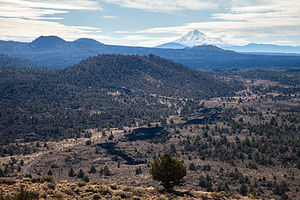 View from Schonchin ButteMost of the caves are located along the one-way Cave Loop Road, just southwest of the visitor center, so we drove and parked at our first victim, Sunshine. We liked the name. However, I don’t think we should have been caving if it was Sunshine we were after. I guess everything is relative. This one was called Sunshine because the roof of it had collapsed in two places allowing sunlight to enter. It was rated Moderately Challenging because stooping was required in several places and the floors in the back section were very steep, rough, and wet. The cave was only 466 feet long, but I would have to say that it felt a lot longer.
View from Schonchin ButteMost of the caves are located along the one-way Cave Loop Road, just southwest of the visitor center, so we drove and parked at our first victim, Sunshine. We liked the name. However, I don’t think we should have been caving if it was Sunshine we were after. I guess everything is relative. This one was called Sunshine because the roof of it had collapsed in two places allowing sunlight to enter. It was rated Moderately Challenging because stooping was required in several places and the floors in the back section were very steep, rough, and wet. The cave was only 466 feet long, but I would have to say that it felt a lot longer.
For our second cave, we chose an easier but longer one called Sentinel Cave. This is the only one that has two entrances, so you can through hike from Upper to Lower Sentinel Cave for a total distance of 3,280 feet. And, we didn’t have to stoop in this one, but could walk upright with dignity. Although it was rated as Least Challenging, it was still a bit disconcerting to be in such a dark place. Of course we had headlamps—you wouldn’t get 50 feet without them—but we turned them off at one point. It was unbelievably silent and scary. I don’t know what I would have done if the batteries went dead.
We picked one more cave because we liked the name: Skull Cave. This one was not on the Cave Loop but about 2.4 miles up the road from the Visitor Center. Although it was named for the bones of pronghorn sheep and two human skeletons found inside, we fortunately did not stumble across any. This cave, which was rated Least Challenging, is 580 feet long.
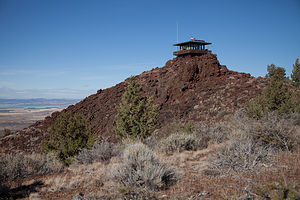 Schonchin Butte Fire LookoutFiguring three caves had given us a sufficient sampling of a really cool geological feature, we devoted the rest of the day to activities out in the real sunshine. While the caves are the main draw to Lava Beds National Monument, there are many more interesting volcanic features, as well as a pretty exciting human historical past, to explore.
Schonchin Butte Fire LookoutFiguring three caves had given us a sufficient sampling of a really cool geological feature, we devoted the rest of the day to activities out in the real sunshine. While the caves are the main draw to Lava Beds National Monument, there are many more interesting volcanic features, as well as a pretty exciting human historical past, to explore.
Continuing up the park road, our next stop, and probably my favorite of the day, was the 0.7 hike up Schonchin Butte, a cinder cone with a Fire Lookout on top. When we got to the top, the friendly fire ranger and his wife (who told us she liked coming along with her husband to work when she could) waved us to come on up. Wow. At the Black Butte Lookout in Sisters, we weren’t allowed to climb the tower or bother the fire rangers that lived in the tiny cabin nearby. I guess the difference was that this guy didn’t live up here, but commuted each day with his food and supplies. He was so friendly, and we learned a lot about detecting and fighting forest fires. He also pointed out Lassen Peak for us.
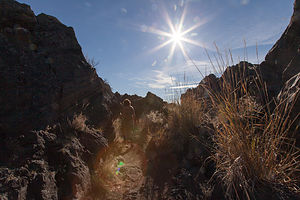 Captain Jacks Stronghold HikeWe passed the turnoff for Fleener Chimneys—we would hit that on the way back—and stopped at the parking lot for Black Crater. While a longer 1.1 mile trail leads to the site of a Modoc Indian battle, we just took a short side trail from the parking lot to Black Crater, a large spatter cone.
Captain Jacks Stronghold HikeWe passed the turnoff for Fleener Chimneys—we would hit that on the way back—and stopped at the parking lot for Black Crater. While a longer 1.1 mile trail leads to the site of a Modoc Indian battle, we just took a short side trail from the parking lot to Black Crater, a large spatter cone.
Lava Beds was truly a geologist’s paradise, with such a variety of volcanic features to explore. Those TTC geology lectures were certainly coming in handy. Also, our younger son Tommy majored in Geology in college and took a field trip to Hawaii to study volcanoes. It was nice to finally understand a bit of what he had studied.
Most of the lava in Lava Beds National Monument is basaltic, which is thinner and flows faster than other types of lava, such as andesite. The two most common types of basaltic lava flows are pahoehoe and A’a. Pahoehoe is the most common type found in Lava Beds. It is smooth and ropy and forms when lava cools slowly and doesn’t move too fast. A’a is rough and sharp. It forms when lava cools quickly and moves fast, tearing it into jagged pieces.
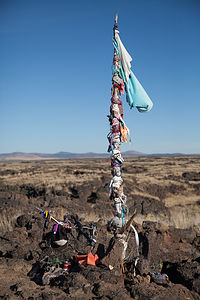 Native American Medicine PoleAn excellent place in Lava Beds to see a’a lava is the Devils Homestead Flow, just north of Black Crater. It's a vast expanse of black, jagged rocks with no vegetation in sight. It looked like another planet.
Native American Medicine PoleAn excellent place in Lava Beds to see a’a lava is the Devils Homestead Flow, just north of Black Crater. It's a vast expanse of black, jagged rocks with no vegetation in sight. It looked like another planet.
We got out of the car at the scenic overlook and, I must confess, I put a few samples of a’a in my pocket. I wanted to show Tommy that I learned something about geology. I would have to find some pahoehoe later to add to my new lava collection.
To understand the significance of the next two stops, you have to know a little about the human history that unfolded in Lava Beds.
Back in 1872, the Modoc Indians and the U.S. Army went to war over this territory. The U.S. Army outnumbered the Modoc 10 to 1, but the Modocs, under the leadership of Captain Jack, were able to fend them off for sometime by hiding out in an natural fortress now called Captain Jacks Stronghold. When we hiked through this area, we understood why they picked it as a fortification. It was an ancient lava flow of rough and jagged rock (must have been a’a!) that made it almost impossible for the U.S. Army to cross.
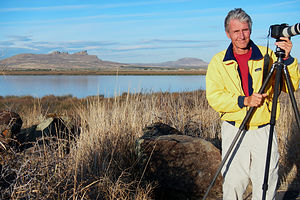 Herb of Tule LakeFinally, President Grant called for a peace conference to be held between the Modoc and the U.S. Army at a location west of the Stronghold, now called Canby Cross. Unfortunately, this meeting did not go as planned. Two Modoc warriors managed to shame Captain Jack into shooting the U.S. General Canby in the face, killing him. Obviously, that did not help the peace negotiations and the war went on. Eventually the Modoc were defeated and Captain Jack was hung for his crime.
Herb of Tule LakeFinally, President Grant called for a peace conference to be held between the Modoc and the U.S. Army at a location west of the Stronghold, now called Canby Cross. Unfortunately, this meeting did not go as planned. Two Modoc warriors managed to shame Captain Jack into shooting the U.S. General Canby in the face, killing him. Obviously, that did not help the peace negotiations and the war went on. Eventually the Modoc were defeated and Captain Jack was hung for his crime.
We made a stop at both of these places – Canby Cross to see the memorial to the unfortunate General Canby and Captain Jacks Stronghold, where we hiked the 1.5 mile trails through the amazing natural fortress of lava.
It’s a pretty somber place when you think about what happened here. Most of the Modoc survivors were exiled to the Quapaw Reservation in Oklahoma, but gradually a few of them have begun to return to the Lava Beds to reestablish their spiritual bonds to the land of their ancestors. I’m not sure, but I think we might have come across a place where that was being done – or maybe it was just tourists gone awry.
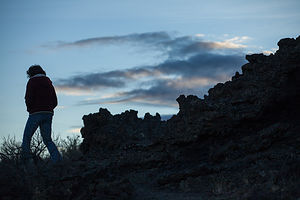 Lolo of Fleener ChimneysAt the junction of the inner and outer trails at Captain Jacks Stronghold, we came across a medicine pole, or more correctly a medicine branch stuck in the ground, almost completely decorated with a miscellany of stuff—bandanas, flags, feathers, etc. It reminded me of one of those Dutch paintings that are so detailed that you can spend hours looking at it and still find something new. With closer scrutiny we found a baby shoe, a compass, and a Livestrong bracelet, just to name a few objects. I am not sure if these items were random or whether they had any spiritual significance. The Campbell Soup can had me pretty stumped.
Lolo of Fleener ChimneysAt the junction of the inner and outer trails at Captain Jacks Stronghold, we came across a medicine pole, or more correctly a medicine branch stuck in the ground, almost completely decorated with a miscellany of stuff—bandanas, flags, feathers, etc. It reminded me of one of those Dutch paintings that are so detailed that you can spend hours looking at it and still find something new. With closer scrutiny we found a baby shoe, a compass, and a Livestrong bracelet, just to name a few objects. I am not sure if these items were random or whether they had any spiritual significance. The Campbell Soup can had me pretty stumped.
After Captain Jack’s Stronghold, the road traced the southern shore of Tule Lake, where we stopped at one of the overlooks. I had had the foresight to pack some wine and cheese, so we sat for awhile by the lake and watched the sun go down.
On the way back to the campground, we stopped at the one stop we missed when driving north, the Fleener Chimneys, the source of all that lava in Devils Homestead. It was already almost dark so we had to be quick. This was another example of a spatter cone, which is created when erupting globs of molten lava get piled up on each other. When this one was created it left a 50-foot deep chimney behind in the center, hence the name, Fleener Chimneys.
It had been a very full day and we had covered a lot of ground through thousands of years of tumultuous history, both geological and man-made. Herb was right. This was a very worthwhile stop indeed.
Description
 Lolo Approaching Lava Tube Cave EntranceLava Beds National Monument in northeastern California comprises 46,000 acres of rugged landscape dotted with diverse volcanic features, such as lava tube caves, cinder cones, spatter cones, fumaroles, pit craters, and lava flows, which were created over the last half million years by volcanic eruptions on the Medicine Lake shield volcano.
Lolo Approaching Lava Tube Cave EntranceLava Beds National Monument in northeastern California comprises 46,000 acres of rugged landscape dotted with diverse volcanic features, such as lava tube caves, cinder cones, spatter cones, fumaroles, pit craters, and lava flows, which were created over the last half million years by volcanic eruptions on the Medicine Lake shield volcano.
What makes Lava Beds National Monument unique among its volcanic peers is its more than 330 lava tube caves. These tubes were formed when lava flowing from the erupting Medicine Lake volcano began to cool and harden on the outer edges, while hotter lava in the core continued to flow within, forming a giant underground tunnel system of tubes and caves.
Over two dozen of these lava caves, of varying difficulty, length, and complexity, have developed entrances and trails for visitors to explore. All you need are sturdy shoes, a good flashlight, and a helmet (for the more challenging caves). Most of the caves are located along the one-way Cave Loop Road, just southwest of the visitor center. The Visitor Center has a brochure describing each of the caves in terms of difficulty and length.
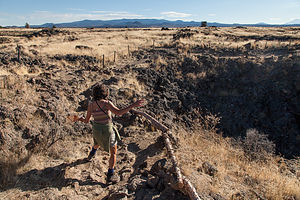 Lolo Hiking Captain Jacks StrongholdBesides its tumultuous geological past, this area has also had its share of human violence. From 1872 to 1873, the Modoc Indians used this rugged terrain to defend their territory from the U.S. Army, which outnumbered them 10 to 1. Under the leadership of Captain Jack, about 50 Modoc warriors and their women and children hid out in a natural stronghold near the shores of Tule Lake, where ancient lava flows had formed a rugged, uneven terrain, difficult for the U.S. Army to cross. After an unsuccessful siege attempt, President Grant arranged for a peace conference to be held with the Modoc leaders at a location west of the Stronghold. However, two Modoc warriors shamed Captain Jack into shooting and killing General Canby at this peace meeting. The Modoc were eventually defeated and Captain Jack hung for his crime. The Modoc survivors were exiled to the Quapaw Agency in Oklahoma. In recent years, a few Modoc have begun to return to the Lava Beds to try to reestablish their spiritual bonds to the land of their ancestors.
Lolo Hiking Captain Jacks StrongholdBesides its tumultuous geological past, this area has also had its share of human violence. From 1872 to 1873, the Modoc Indians used this rugged terrain to defend their territory from the U.S. Army, which outnumbered them 10 to 1. Under the leadership of Captain Jack, about 50 Modoc warriors and their women and children hid out in a natural stronghold near the shores of Tule Lake, where ancient lava flows had formed a rugged, uneven terrain, difficult for the U.S. Army to cross. After an unsuccessful siege attempt, President Grant arranged for a peace conference to be held with the Modoc leaders at a location west of the Stronghold. However, two Modoc warriors shamed Captain Jack into shooting and killing General Canby at this peace meeting. The Modoc were eventually defeated and Captain Jack hung for his crime. The Modoc survivors were exiled to the Quapaw Agency in Oklahoma. In recent years, a few Modoc have begun to return to the Lava Beds to try to reestablish their spiritual bonds to the land of their ancestors.
The best way to explore the parks geological and cultural history is to drive the 15-mile road through the park. Starting from the Visitor Center near the southern entrance, the following are some highlights along the way:
- Cave Loop Road – best place to explore the lava caves. There are about a dozen of them here with varying degrees of length and difficulty
- Skull Cave – a short side road leads to a cave with a more wide open feel, better for those that do not like tight, closed-in spaces. It is named for the bones of pronghorn, bighorn sheep, and two human skeletons discovered inside.
- Schonchin Butte – a 1.5 mile roundtrip trail leads to the top of this cinder cone, where there is an historic Fire Lookout still in use
- Fleener Chimneys – a short side road leads to an interesting volcanic feature, known as a spatter cone. It was created when erupting globs of molten lava piled up on each other leaving a 50 foot deep chimney behind in the center
- Black Crater – 1.1 mile trail along the edge of a lava flow to the site of a Modoc ambush on the U.S. Army during the Modoc War.
- Devils Homestead Lava Flow – vast expanse of black, jagged lava from an eruption of Fleener Chimneys 12,000 years ago. It is an excellent example of an a’a lava flow.
- Canby Cross – memorial to General Canby, who during a peace gathering with the Modoc Indians, was shot in the face and killed by Captain Jack of the Modoc. The cross is registered as a California Historical Landmark
- Captain Jacks Stronghold – 1.5 mile trail through a natural fortress of lava, where the Modoc Indians hid out for the winter of 1872-1872 during their war with the U.S. Army.
- Wildlife Overlooks – along the southern shore of Tule Lake are the East and West Overlooks where one can view migratory and resident birds on the waters of Tule Lake
There is one campground in Lava Beds:
- Indian Well Campground - located at the southern end of the park just downhill from the Visitor Center. There are 43 sites, available on a first-come-first-served basis. It can accommodate RVs up to 35 feet in length. The campground is open year round.
- ‹ previous
- 13 of 19
- next ›
Lava Beds National Monument location map in "high definition"
Javascript is required to view this map.
